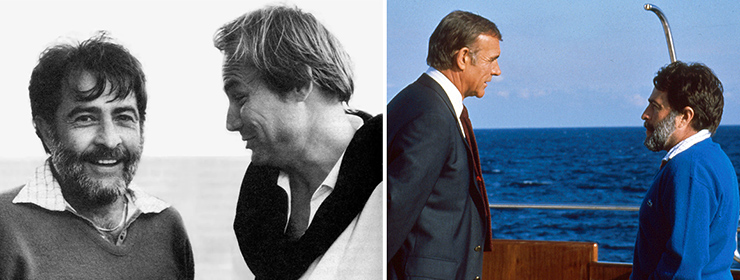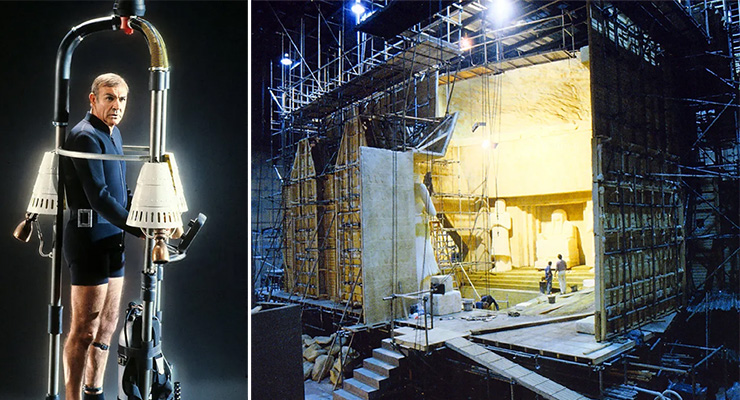|
Never Say |
||
|
||
|
Never Say |
||
|
||
 |
|
In mid-November, Irvin Kershner’s crew left France for Nassau in The Bahamas. The Second Unit had already been hard at work for several weeks off the coast, preparing and filming the tiger shark sequence. The unit was led by underwater director Ricou Browning (1930-2023), who had been responsible for the underwater sequences 16 years earlier on Thunderball. Crew member Robert Steadman revealed that during filming they discovered the remains of the Vulcan bomber from Thunderball (1965) were still lying on the ocean floor! Supervising Art Director Les Dilley recalls that the sunken ship Bond and Fatima were to enter was a 100-foot cargo boat which was revamped, realistically aged, and then sunk 50 feet below the surface half a mile off-shore. Once the ship was in place, Browning and his crew began filming in the wreck with the tiger sharks, all of which were real. Connery himself did a large proportion of the underwater sequences, although apparently the majority of this material was absent from the finished print. It was the first time that Connery, an active sportsman, had done any scuba diving for the cameras since Thunderball. The underwater unit also worked in other Bahamian locations and wrapped off the coast of Florida. Meanwhile on dry land, Kershner began by filming the action-packed opening sequence in the luscious jungle in the centre of Nassau. Wendy Leech, daughter of stunt co-ordinator George Leech (1921-2012), who worked on many Bond movies over the years from Dr. No (1962) to For Your Eyes Only (1981), plays the femme fatale hostage, who Bond is to rescue in his training mission. Wendy is married to Vic Armstrong, Second Unit Director on Tomorrow Never Dies (1997), The World Is Not Enough (1999), and Die Another Day (2002), who was stunt co-ordinator on Never Say Never Again. Wendy served a dual purpose on the film, by also doubling Kim Basinger in various action sequences. |
||||
|
||||
|
Once the crew reached The Bahamas the atmosphere became strained. Producer Schwartzman soon became very unpopular with an increasingly unamused Sean Connery. “In the middle of everything he moved to The Bahamas with an unlisted number. It was like working in a toilet. I should have killed him,” commented a distressed Connery. It wasn’t long before Connery was becoming involved in every decision concerning the production, “There was so much ineptitude and dissension that the film could have disintegrated. The assistant director [David Tomblin (1930-2005)] and myself really produced that picture.” At times it was not unusual for Connery to take personal charge of certain scenes from director Kershner, and he was quick to point out that this was his seventh Bond, and Never Say Never Again was Kershner’s first. Connery had never worked harder in his life. He was later quoted as saying, “I wound up being involved in every aspect of the picture except the music.” Kershner echoed Connery’s feelings, “Jack (Schwartzman) was a very good businessman, but he didn’t have the experience of a film producer. He and I had divergent views of what the film should have been. I tried to maintain what I could of my vision, but you can only do so much when the studio sides with the producer – whether he’s right or wrong.” At The National Film Theatre Guardian lecture in December 1983 Connery said, “What I could have done is just let it bury itself. I could have walked away with an enormous amount of money and the film would never have been finished.” Not only was the film troubled with political problems, but the weather also caused difficulties for the crew. |
||||
 |
||||
|
Kershner also felt that the Never Say Never Again shoot was not the most joyous of experiences, “… the film was not a happy film – in fact it was a very unhappy film for most of the people who worked on it. It was disorganised – totally disorganised. Everyone suffered as a result.” It seems that Kershner became considerably overwhelmed by the whole movie, “I didn’t quite know what I was in for...I miscalculated in some areas. Although The Empire Strikes Back was much more complicated, I had more time to prepare, which made it easier. I didn’t have as much preparation time with Never Say Never Again, which made the day-to-day shooting more difficult.” When interviewed on BBC TV’s Film 83, Connery told film critic Barry Norman, “It should have been a great deal more enjoyable than it was.” The principal artists also felt the tension. Kim Basinger stated shortly after the film wrapped, “There were a lot of problems upstairs. We’d be doing a scene and these guys would be squabbling in the corner. Some of those guys had made a movie before, but none of them had made a Bond movie before. If Sean Connery hadn’t taken over, the film wouldn’t have had any chance at all. As it is, if it turns out to be great, it will be one of the biggest mistakes in the history of the industry.” Filming continued in The Bahamas, on the streets of Nassau, at the Nassau Beach Hotel, and the British Colonial Hotel, before the crew headed back to England. |
||||
|
||||
|
Location filming in England focused around two distinguished stately homes, the French style, Waddesdon Manor, and Luton Hoo, which doubled for Shrublands Health Clinic. Prunella Gee was cast as Bond’s physiotherapist Patricia. She told 007 MAGAZINE shortly after the release of the film “… the big thing about being a so-called ‘Bond girl’ is the locations and the glamour. This one was made in The Bahamas and the South of France and was all very exotic. And they also did 10 days in Luton… and I got 10 days in Luton!!!” While Cubby Broccoli’s EON Productions shot at Pinewood Studios, Schwartzman’s team wrapped their production nearby at EMI Elstree Studios, north of London. Octopussy director John Glen recalls an amusing incident when rushes from Never Say Never Again were actually returned to EON at Pinewood in error. “We were intrigued to see some of their film arrive at Pinewood, but we resisted the temptation to watch it, and rang Elstree to tell them about the mix up. We laughed about it, and quietly swapped the cans over. We even paid for the car over to Elstree.” A number of elaborate sets were constructed at Elstree, including the underwater cavern, ‘The Tears of Allah’, an impressive set which took three months to build. |
||||
|
||||
|
The plot of Never Say Never Again demanded that SPECTRE hijack two American missiles and hold the world to ransom. A great deal of the film depends on an impressive display of technical know-how. The filmmakers brought in as technical advisor, Brendan Alimo, architect, novelist, and an expert on aerospace technology. Never Say Never Again was a very advanced project in terms of special, optical, and visual effects for its time; many new tricks were tried and tested by effects supervisor David Dryer, who came to the movie fresh from Ridley Scott’s ground-breaking Blade Runner (1982). Dryer believed there was no effects company in Great Britain able to accommodate what he had in mind for Never Say Never Again, and eventually the effects were handled by Apogee Incorporated in the United States. Never Say Never Again was the first, and to date thankfully, the last movie to introduce James Bond to the technical world of video games. This was the idea of Jack Schwartzman, “Warner Brothers had given us 100 Atari video arcade games for the casino sequence. It was logistical for these very wealthy French charity guests to be playing video games. And I thought it would be terrific for Bond to play Largo on video. By now, baccarat and chemin de fer were passé in Bond movies, we wanted to update what Fleming had conceived.” |
||||
 |
||||
|
For Sean Connery, Never Say Never Again should have been a happier experience. Instead, it became a logistical nightmare, a legal minefield, an independently financed picture that Connery ended up producing, part-directing, and starring in. Once the dust had settled he commented, “You salvage it best you can. But yes, the hassles did leave me disillusioned with the industry for a while. I even considered writing a little book on it. But then I thought why stir up all the aggravation again. It’s probably better left alone.” After the release of Never Say Never Again, Sean Connery took a well-earned break, the longest of his career, and didn’t make another film for three years. |
||||
|
After the troublesome shoot, Never Say Never Again then moved into post-production. Jack Schwartzman had originally wanted James Horner (1953-2015) to compose the score, but the baton was finally handed to Oscar-winning composer Michel Legrand (1932-2019). The end result was deemed misjudged, and is considered by many as the worst score for a James Bond movie ever. Lani Hall performed the title track, which was partly orchestrated by her husband Herb Alpert, who of course performed the instrumental title track for the first rogue Bond movie Casino Royale (1967). |
||||
|
|